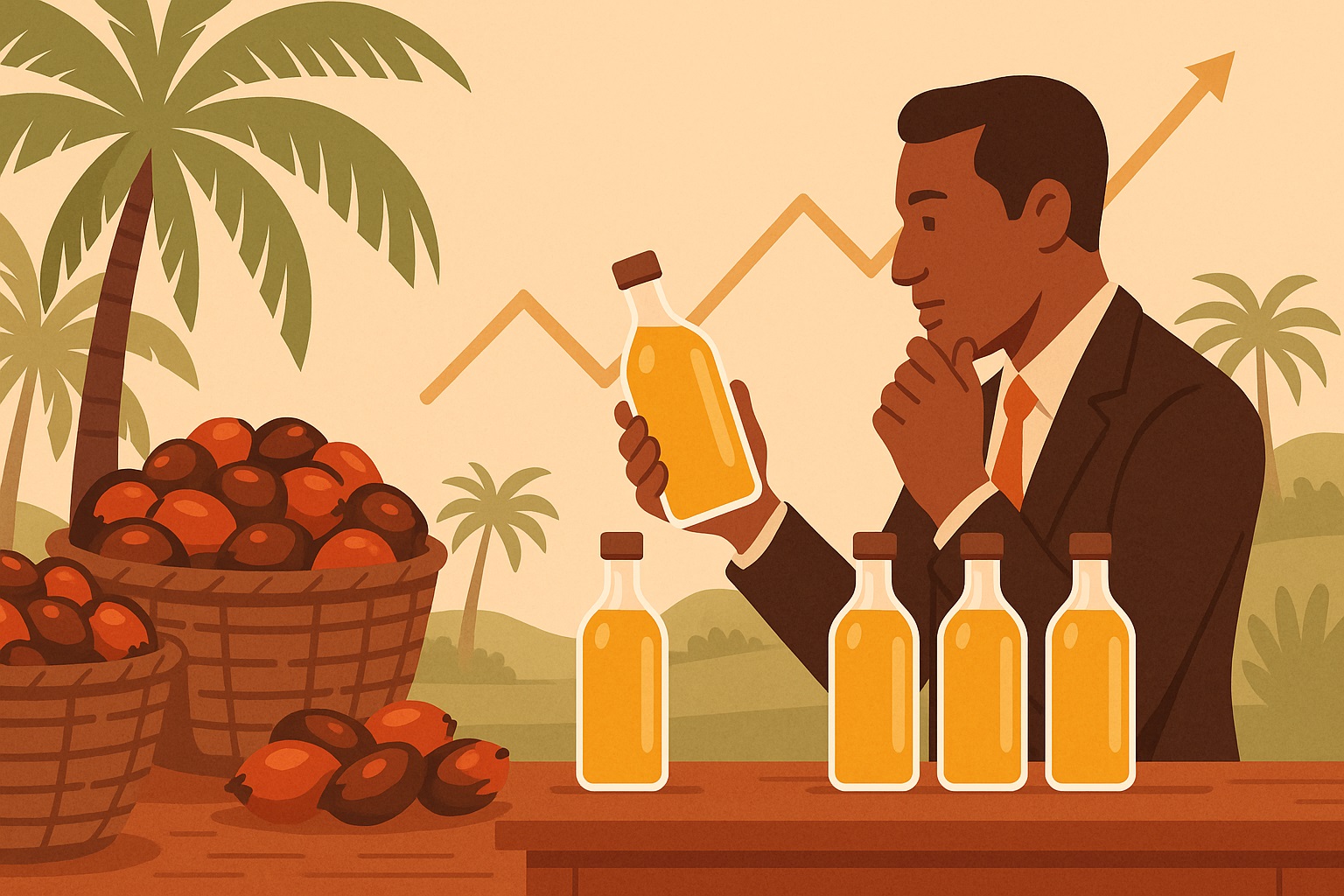Starting a palm kernel oil business can feel exciting and a bit scary at the same time. I know because I began my own little venture with only a small budget and a big dream. Palm kernel oil is in high demand for cooking, soaps, cosmetics and even some industries. In this friendly guide I will walk you through what you need to do to set up a business that makes money and grows over time. I will share what worked for me and what I learned the hard way. Let us jump right in.
1. Learn About Your Market
Before you spend any money you want to know who will buy your oil and at what price. I started by talking to people in my town. I went to small soap makers, restaurant owners, and even street food vendors. I asked them how much oil they use each month and what stops them from buying more. I also went to the market to see what my competitors offer. I wrote down their prices and packaging sizes. Then I checked online to see if there was demand outside my area, maybe for export. When I saw some buyers in Europe pay much more for organic or fair trade palm kernel oil, I knew there was extra profit if I did my homework.
2. Write a Simple Business Plan
A full business plan can feel intimidating but you only need the basics to start. My plan had these sections:
• A short overview of my idea and my profit goals
• A summary of what I learned from talking to buyers and checking prices
• How I planned to get the kernels and extract the oil
• My marketing ideas, like selling online or at local fairs
• A rough budget of costs and how many liters I needed to sell each month to break even
Even this simple plan kept me from spending too much on equipment I did not need yet.
3. Find Good Palm Kernels
Great oil starts with great kernels. You have two main choices. You can buy directly from farmers or from traders who already collect in bulk. I chose a mix of both. I paid farmers a fair price for fresh kernels. That built loyalty. At the same time I bought from a local trader when I needed more volume. When you look for suppliers check for kernels that are dry and free of dirt or bits of shell. Test a small sample in your press before you commit to large orders.
4. Pick Your Extraction Method
There are a few ways to get oil out of the kernels. At first I used a manual screw press. It is cheap and easy to learn. It gives a yield of about 35 to 40 percent oil from the dry weight of kernels. As I grew, I switched to an electric screw press that handles up to 100 kilograms of kernels per hour. That increased my yield to about 45 percent and saved me a lot of time and sweat. If you plan to scale even bigger you could look into solvent extraction that pulls more oil but costs more and needs special equipment.
5. Set Up Your Workshop
I found a small warehouse near the farmers I worked with. It had enough space for storing kernels, processing, and packing. You do not need a fancy building. You just need dry, clean floors and room for your machines, a workbench, and shelves. My layout looked like this:
- A corner for raw kernels
- A small dryer for kernels when they arrive damp
- The extraction area with my electric press and a small heater
- A filtration table with cloth filters
- A packing station with bottles, labels and seals
- A shelf for finished oil and a bin for spent cake that I sold as animal feed
I also set aside a space for quality checks and for mixing any refined oil batches later.
6. Keep Your Quality High
Customers come back when they trust your oil. I tested each batch for moisture using a simple meter. I checked that acidity stayed low by sending samples to a local lab now and then. I looked at the color and smelled the oil to make sure it smelled fresh and nutty. When something was off I stopped selling that batch until I knew the problem. Over time I built a short checklist and trained my small team to follow it before any shipment left our door.
7. Refine and Package Your Oil
The raw oil you get from the press is often dark and cloudy. If you want to sell to food businesses or cosmetic makers you might need to refine it. I did a simple refining first. I let the oil settle in a tank so heavy particles sank to the bottom. Then I gently heated it and mixed in a little bleaching earth clay to remove color. Finally I steamed it lightly so strong odors faded. The result was oil that looked clear and light, with a gentle aroma.
For packaging I chose two lines. One line of 20 liter plastic jerry cans for soap makers and restaurants. Another line of one liter PET bottles for home cooks. Later I added a small glass bottle range for organic food stores and cosmetics buyers. Labels included my brand name, a simple logo, nutritional facts, batch number and best before date.
8. Follow Rules and Get Permits
It can feel like a headache but you want to avoid trouble. I registered my business name at the local trade office and got a basic food handler permit from the health department. If you plan to export check what standards you need, like organic or fair trade certificates. Solvent extraction operations often need environmental clearance so you must check waste disposal rules. I found a friendly business advisor who helped me fill the forms.
9. Build Your Brand
A good logo and clear packaging helped people trust my oil. I chose a bright green bottle label to hint at nature and health. I made a simple website with pictures of my farm partners and how we process the oil. On social media I posted short clips of how to use palm kernel oil in cooking or skincare. When I attended a trade fair I let people smell and taste samples. I also offered small soap bars made from my oil so cosmetic makers could see the quality.
10. Find Buyers and Distribute
My first sales came from people I already talked to during my market research. Soap makers and small restaurants took my jerry cans first. Then I used a simple strategy. I offered free delivery for orders above a certain size. I gave small discounts to regular customers and asked them to refer me to others. I also listed my bottles on an online marketplace focused on local products. As orders grew I hired a motorbike courier to handle city deliveries. For bulk buyers outside my area I partnered with a freight forwarder who handled packaging and shipping.
11. Manage Your Money
Palm kernel oil can tie up cash in inventory, so I learned to keep enough reserve. I calculated my cost of goods sold by adding up kernel cost, electricity, labor, packaging and transport. I aimed for a profit margin of at least 30 percent on my retail bottles and 20 percent on bulk cans. I used a simple spreadsheet to track sales and expenses each week. That told me when I could reinvest in new equipment or hire extra help.
12. Scale Up Slowly
After a few months of steady sales I bought a second electric screw press. That doubled my capacity so I could serve more orders. Then I introduced a refined oil line that sold at a higher price. I also sold my cake byproduct as animal feed to a local poultry farm. That added extra income without extra work. Each time I scaled I made sure my cash flow could handle it.
13. Keep Improving
Running this business has been a learning journey. I talk every month with my suppliers to make sure kernels stay fresh. I check customer feedback and tweak my refining process when buyers ask for lighter color or milder taste. I test new packaging sizes based on demand. Some days are hard. Machines break down, or a buyer pays late. But each challenge taught me something new and made my business stronger.
14. Final Thoughts
Starting a palm kernel oil business is not a get rich quick scheme. It takes hard work, patience and smart choices. But if you follow these steps you can build a business that grows over time. Learn your market, keep quality high, build your brand and manage your money carefully. Scale when you are ready, not just because you want faster growth. With persistence and good service you will earn loyal customers who trust your oil.
I hope my story and advice help you begin your own journey. Good luck and enjoy building your palm kernel oil business!


